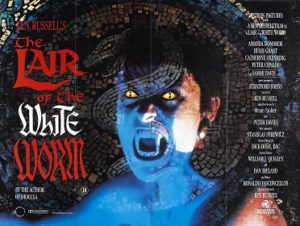 Goofy eighties horror-comedy from Ken Russell, whose finest work this definitely isn’t. It is worth a watch, though.
Goofy eighties horror-comedy from Ken Russell, whose finest work this definitely isn’t. It is worth a watch, though.
THE LAIR OF THE WHITE WORM (1988) was the penultimate entry in a multi-picture deal Ken Russell had in the mid-1980s with the late Vestron Pictures. Russell’s other Vestron films were GOTHIC, SALOME’S LAST DANCE and THE RAINBOW, all made in quick succession, and all superior to LAIR in my view, even though it has gone on to become the most popular of the lot. A few actors from the other pictures reappeared in LAIR (Sammi Davis, Amanda Donohoe, Stratford Johns) and there’s also an appearance by a young Hugh Grant, who wears too much eye shadow.
The film was adapted from a 1911 novel, the final book of DRACULA’S Bram Stoker. It was based on the myth of the “Lambton Worm” of North East England, and written, reportedly, when the author was half-mad. That explains why the film’s narrative is so blah.
It features the studly young Lord James D’Ampton returning to his ancestral castle in North East England. Around the same time a prehistoric animal skull is unearthed at the sight by Angus, a young archeology student. The discovery of the skull seems to tie in with James’ family history, which decrees that a distant relative once slayed a dragon.
Also taking an interest in the unearthed skull is Lady Sylvia Marsh, a wealthy seductress/vampire residing nearby. She steals the artifact for use in her vampiric rituals, the latest of which involves an unfortunate young hitchhiker she bites on the penis. She also spits on a crucifix, which when touched by James’ girlfriend Eve causes infernal hallucinations involving rape and crucifixion.
James teams us with Angus in an effort to track down the missing skull, but only after a tryst with Lady Sylvia. More creepy hallucinations follow, as it becomes clear that Lady Sylvia has many snake-like qualities—and that the tale about the dragon who menaced James’ ancestors isn’t entirely fictional. In fact, it seems the dragon, or White Worm, is still extant under the castle, and waiting to be resurrected.
Ken Russell’s style here isn’t as overpowering as it was in THE DEVILS or GOTHIC, but it is evident in the frequent use of wide angle lenses and hallucinogenic dream sequences. Both elements are gracefully incorporated into the overall film, demonstrating Russell’s undeniable filmmaking prowess and flair for campy comedy. There’s nothing remotely scary in this film, but as a gothic camp fest it works, with an air of cheerful outrageousness that’s pure Ken Russell. Only the inimitable Mr. Russell could get away with a dream sequence that casts the film’s heroines as lesbian airline stewardesses, or a climax involving a dildo-wielding femme fatale and the goofiest looking giant serpent this side of Reptilicus.
That, however, doesn’t change the fact that the material is tired and uninteresting. None of the characters are the slightest bit compelling, nor the actors who play them. The lone exception is Amanda Donohoe as the fiendishly seductive Lady Sylvia Marsh. Donohoe out of all the cast members really seems to understand the film’s comedic tone, and more than fulfills the alluring sexiness her role demands.
Vital Statistics
THE LAIR OF THE WHITE WORM
Vestron Pictures
Director/Producer/Screenwriter: Ken Russell
(Based on a novel by Bram Stoker)
Cinematography: Dick Bush
Editing: Peter Davies
Cast: Amanda Donohoe, Hugh Grant, Sammi Davis, Catherine Oxenberg, Peter Capaldi, Stratford Johns, Paul Brooke, Imogen Claire, Chris Pitt, Gina McKee, Christopher Gable, Lloyd Peters
